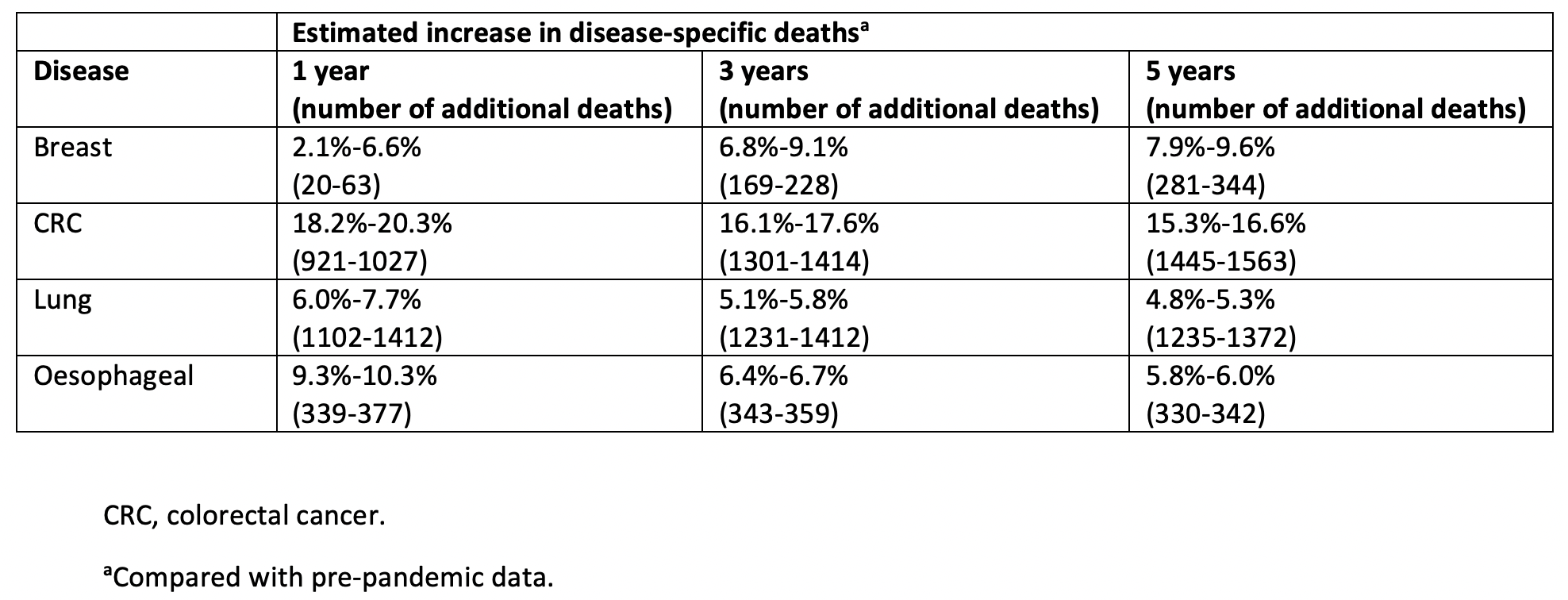Article
Long-Term Consequences for Cancer Detection Loom Amid COVID-19
Author(s):
The coronavirus disease 2019 has disrupted the global delivery of coordinated cancer care, resulting in declines in routine screening and referrals that could lead to thousands of excess deaths due to delayed diagnoses, experts warn.
Norman E. Sharpless, MD

The coronavirus disease 2019 (COVID-19) has disrupted the global delivery of coordinated cancer care, resulting in declines in routine screening and referrals that could lead to thousands of excess deaths due to delayed diagnoses, experts warn.
In both the United States and the United Kingdom, COVID-19–related interruptions to primary and specialty care have translated to deferrals in routine, nonurgent diagnostic screening. New data from a model of the effect of COVID-19 on cancer screening and intervention for patients with breast and colorectal cancer (CRC) indicates that this “unprecedented disruption” in cancer care will cause nearly 10,000 excess cancer deaths across the nation over the next decade. The 1% increase in these disease-specific deaths is expected to peak in 2021 or 2022, adding to the approximate 1,000,000 breast and CRC deaths investigators expect over 1 decade under normal clinical circumstances.1
“Ignoring life-threatening non–COVID-19 conditions such as cancer for too long may turn 1 public health crisis into many others,” Norman E. Sharpless, MD, director of the National Cancer Institute, wrote in an editorial published in Science on June 19, 2020.1
Nevertheless, recent research has shown that patient fear of contracting COVID-19 has catalyzed changes in health service-seeking behavior. Data from Maringe et al demonstrated that urgent 2-week-wait referrals for patients with suspected cancer decreased 80% in the UK since March of 2020. These referrals are often associated with later stage disease than diagnoses made during routine general practitioner and secondary care referrals and screenings.2
With the destabilization of primary and specialty care induced by the COVID-19 pandemic, reduced access to specific health services, and patient apprehension, comes an increased risk for premature mortality. From 1900 to 2017, there has been a 29% drop in the number of cancer deaths in the US, thanks to high-fidelity diagnostic screening tools and increased adoption of routine screening for various malignancies. “This decline is due to prevention of disease due to effective screening and effective treatment and has been cited as evidence that we are making progress in our cancer effort or in what some people refer to as our ‘war,’” Otis W. Brawley, MD, said during a presentation at the 2020 American Association for Cancer Research (AACR) Virtual Meeting: COVID-19 and Cancer.3
Although longer lapses in screening will affect disease-specific mortality rates in varying severities, in most cases, short-term deferrals are not likely to impact these outcomes or the US cancer death rate, Brawley explained. “A delay of 6 or more months could affect mortality and outcomes in some cancers, but a delay of just 3 months or so is not likely to affect overall mortality,” Brawley said. “The greater concern is the patient who finds the mass and delays assessment and treatment because of the pandemic as well as delays in treatment.”
UK Diagnostic Delays Will Be Debilitating
Medical professionals are calling for increased visibility of the perils inherent in postponing screening for prolonged periods of time as emerging data continues to affirm these risks. In a national, population-based study, investigators sought to model the impact of COVID-19–related diagnostic delays on survival for patients with CRC, as well as breast, oesophageal, and lung cancers in the UK. To facilitate this research, investigators used linked English National Health Service cancer registration and hospital administrative datasets for patients aged 15 to 84 years who received a diagnosis of breast cancer, oesophageal cancer, or CRC between January 1, 2010 and December 31, 2020, and had follow-up data available through December 31, 2014. They also evaluated patients with lung cancer diagnoses made between January 1, 2012 and December 31, 2012, with follow-up data through December 31, 2015.2
Investigators implemented a routes-to-diagnosis framework to approximate the effect of diagnostic delays over a 12-month period, from the introduction of social distancing orders on March 16, 2020, up to 1, 3, and 5 years after the diagnosis of cancer. These measures were selected to generate data that would support an analysis of deaths attributable to cancer and total years of life lost postpandemic compared with prepandemic data. The analysis included 32,583 patients with breast cancer, 24,975 patients with CRC, 29,305 with lung cancer, and 6744 with oesophageal cancer.
Three different scenarios pertaining to possible COVID-19–related changes to referral patterns were tested: Scenario A, estimating survival outcomes for patients by reallocating those who are expected to receive a diagnosis of cancer through screening and routine referral pathways, specifically, general practitioner or secondary care; scenario B, which is the same as scenario A, but with simulation of the effect of an 80% reduction in 2-week-wait referrals from March 16, 2020; and scenario C, which is the same as scenario B, but with simulation of the effect of 2-week-wait referrals continuing to be reduced beyond the first 3-month period by 25% for a further 3-month period. Of note, the 80% decrease in 2-week-wait referrals addressed in scenario B has already been observed in England during the COVID-19 lockdown and it is assumed that the reduction will continue for up to 3 months due to COVID-19–related concerns.
Findings showed that the deaths for each malignancy Across scenarios A through C increased in each post-pandemic scenario more rapidly compared with pre-pandemic conditions up to year 5 after diagnosis. Specifically, the estimated rise in cancer deaths at 5 years after diagnosis were 7.9% to 9.6% for breast cancer, 15.3% to 16.6% for CRC, 4.8% to 5.3% for lung cancer, and 5.8% to 6.0% for oesophageal cancer (Table).2
Altogether, deaths due to diagnostic delays and the shifts in patient health-seeking behaviors, are projected to culminate in 59,204 to 63,229 total years of life lost.2
Table. COVID-19–Related Referral Shifts Projected To Drive UK Cancer Death2

US Disease-Specific Mortality Expected To Arch
Primary care physicians play a crucial role in referring patients to screening, prevention, and treatment resources. As primary care visits decrease, so do patient referrals,3 Brawley explained. Data shows that primary care visits for wellness and preventive purposes have rapidly decreased in recent months. The burden has been particularly high in primary specialties such as ophthalmology, dermatology, urology, and cardiology, where patient visits fell 47%, 42%, 39%, and 40%, respectively, between March 15, 2020 and June 20, 2020.4
These sharp declines in primary care visits have led to fewer cancer diagnoses, in addition to myocardial infection, stroke, and diabetes diagnoses. Long-term implications of this current clinical reality include delayed detection of malignancies that require diagnostic screening and care, and consequently, poorer outcomes for patients across the cancer spectrum specifically.3 “It is certain that there will be increased deaths because we are decreasing the intensity [with] which we are diagnosing and treating cancer in the United States because of the pandemic,” Brawley said.
Screening is standard in cervical, breast, prostate, lung, and colon and rectum cancers, and its preventive benefit cannot be overstated, Brawley said. “There has been a 40% decline in breast cancer-specific mortality from 1988 to 2018. National Cancer Institute CISNET [Cancer Intervention and Surveillance Modeling Network] Models estimate that screening accounts for 28% to 65% of that decline, with a median of 46%,” he added.3
Failure to follow accepted screening guidelines or receive appropriate treatment comprised 9.5% to 11.3% and 21.2% to 27.0% of all pre-pandemic breast cancer deaths, respectively. As a result, ruptures in the delivery of necessary therapy are expected to be much more of a concern during the pandemic than a slow down in screening. Nevertheless, screening remains a critical component of cancer care that, in order to be optimally used, should not be delayed for long periods of time, Brawley said.3
Beyond breast cancer, screening has also driven a disease-specific drop in colon cancer. Since 1980, there has been a 50% reduction in CRC mortality in the US, and more than half of this decline is thought to be due to screening. Specifically, CRC screening is thought to reduce the risk of death by at least 35% and the risk of cancer diagnosis through polypectomy by a minimum of 20%.3
Although diagnostic delays that span several months are not a concern, declines in the number of patients with cancer treated during a 3-month shutdown will have significant effects on mortality, Brawley said. Cancer staging and the rate of growth are determinants of just how deadly some diagnostic and treatment delays will ultimately prove during this period of time.
“Different types of cancer have different degrees of urgency. Low-grade prostate cancers grow slowly, so patients may be able to delay treatment with few consequences, whereas leukemia requires more frequent and immediate care,” Lawrence Shulman, MD, deputy director for Clinical Services and director of the Center for Global Cancer Medicine at the University of Pennsylvania in Philadelphia, said in National Academies workshop, Opportunities and Challenges for Using Digital Health Applications in Oncology.5
Emerging Data Crystallize Detriment
In recent months, there have been several investigative efforts aimed at approximating how the COVID-19–related reduction in screening will affect the timing and staging of future cancer diagnoses. Data from some of these studies were presented at the 2020 AACR Virtual Meeting: COVID-19 and Cancer, and included findings from a study of the monthly rates per 1000 people of mammography/tomosynthesis, total prostate specific antigen (PSA) testing, and breast and prostate biopsy in a large healthcare provider group in central Massachusetts. Investigators assessed the rate at which these procedures were performed during the first five months of 2020 compared with the same months in 2019.6
Findings demonstrated a “precipitous decline in preventive and diagnostic procedures for breast and prostate cancer,” according to Mara M. Epstein, ScD, who presented the data during the 2020 AACR Virtual Meeting: COVID-19 and Cancer. “During the peak of COVID-19 in central Massachusetts, which was heavily impacted by [COVID-19], we observed that rates of breast screening procedures declined more than prostate cancer tests,” added Epstein, an assistant professor in the Department of Medicine at the University of Massachusetts Medical School in Boston.
In 2020, combined rates for mammography and tomosynthesis fell by 57% in March, 96% in April, and 95% in May compared with 2019. “These tests were essentially stopped completely during the peak of the pandemic,” Epstein said. The number of breast biopsies performed dropped between 96% and 100% in April 2020 and between 89% and 97% in May 2020. Seventy-four breast and lymph node biopsies were conducted each month in 2019 versus 40 each month during the first 5 months of 2020.6
Data from prostate biopsies were incomplete and consequently were not included in the findings. PSA testing decreased in frequency in 2020, declining by 64% in March, 83% in April, and 69% in May compared with 2019 testing data. The study included 80,629 women and 65,312 men in its 2019 dataset and 82,695 women and 66,396 men in its 2020 dataset. Individuals with a history of breast or prostate cancer were excluded from the analysis, which encompassed patients aged 30 to 85 years who were actively receiving treatment between January 2019 and May 2020. To facilitate the year-to-year comparison of mammography/tomosynthesis, PSA testing, and breast and prostate biopsy, investigators used CPT codes in the provider group’s electronic health record. Importantly, all procedures encompassed in the evaluation were completed, not just ordered.6
The large population analysis was conducted in a rich and comprehensive database of electronic health record data compiled in real-time. The procedures studied should be further examined in a broader population, but nevertheless illustrate the volatile dips in screening and diagnostic services induced by the COVID-19 pandemic, Epstein concluded.
References
- Sharpless NE. COVID-19 and cancer. Science. 2020;368(6497):1290. doi:10.1126/science.abd3377
- Maringe C, Spicer J, Morris M, et al. The impact of the COVID-19 pandemic on cancer deaths due to delays in diagnosis in England, UK: a national, population-based, modelling study. Lancet Oncol. Published online July 20, 2020. doi:10.1016/S1470-2045(20)30388-0
- Brawley O. The effects of the COVID-19 pandemic on cancer prevention and control. Presented at: 2020 American Association for Cancer Research Virtual Meeting: COVID-19 and Cancer; July 20-23, 2020; Virtual.
- Mehrotra A, Chernew M, Linetsky D, Hatch H, Cutler D. The impact of the COVID-19 pandemic on outpatient visits: practices are adapting to the new normal. The Commonwealth Fund. June 25, 2020. Accessed July 29, 2020. bit.ly/2X3Wt83
- Will COVID-19 permanently change cancer care? The National Academies of Sciences, Engineering, and Medicine. July 20, 2020. Accessed July 28, 2020. bit.ly/3jNbXXY
- Epstein MM, Sundaresan D, Fair M, et al. Impact of COVID-19 on breast and prostate cancer screening and early detection in a large healthcare provider group. Presented at: 2020 American Association for Cancer Research Virtual Meeting: COVID-19 and Cancer; July 20-23, 2020; Virtual.









